Email overdue and reservations notices
It is possible to have overdue and reservation notices delivered by email.
Supervisor parameters
To begin, some settings need to be set in the Supervisor module (this need only be done once):
- Launch the Amlib client.
- Go to Main > Supervisor > Installation. The Default Installation screen will open.
- Select the Other tab.
- Scroll down to set the following: E-mails are sent using the following method: (M)API or (I)nternal or (S)MTP. Set to S, I or M.
Generally (S) SMTP is recommended, especially as it is simple and it has advantages over the others. It also means that the email client does not need to be open on the PC running the notices and allows greater flexibility with regard to setting up “from” and BCC/CC parameters.

Then the following parameters should also be set (a full table is included below):- SMTP Blind Carbon Copy e-mail address: You can specify the BCC address to send a copy of all notices (so that you can verify that they have been sent).
- SMTP sender e-mail address: The email address to display on the notice sent to the borrower (For example: enquiries@amlib.com.au, it can be the same as the BCC address).
- SMTP Server name: The address of the SMTP mail server being used. This might be a server address or an IP address.

- Click the F3 Save button.
- Once complete, you must exit and reopen the Amlib client to allow the settings to take effect.
The complete set of parameters to consider:
| description | explanation | example |
|---|---|---|
| E-mails are sent using: (M)API or (I)nternal OR (S)MTP or SMTPMailer (D) LL |
Generally (S) SMTP is recommended, especially if the organisation is not using a Microsoft Exchange Server. It also means that the email client does not need to be open on the PC running the notices AND can display the “from” name from one of the parameters below rather than the email address from the email client. | Set to S, I, or M ( S is the default one for internal mail – does not use Transport Security ) OR If using a SMTPMailer service such as Gmail.com or Outlook.com set this to D |
| SMTP Blind Copy e-mail address | Optional: If using the SMTP for emails. Enter only if copies of the email are to sent to a chosen email address – for example: Testing purposes | library@amlib.com |
| SMTP sender e-mail address | Optional: If using the SMTP for emails, enter the Address you wish to indicate as the sender | enquiries@amlib.com.au |
| SMTP server login | Optional: From your Systems Administrator if required – required by systems using encryption | For Gmail this is: smpt.gmail.com If not using a SMTPMailer service leave blank |
| SMTP Server name or IP address | If using the SMTP for emails, enter the Server Name or IP Address of the Server installed with the e-mail communication protocol, responsible for receiving and forwarding email messages | ServerName – for example: server.amlib.com.au or your IP address such as 199..199.94.94 ( this needs to be set for all email setups) |
| SMTP server password | Optional: From your systems administrator if required – required by systems using encryption | You will need to set this if using a SMTPMailer service otherwise leave blank |
| SMTP Server Port Number | Only needs to be set for those using SMTP Transport Security or if you have selected D above | (S)SL = port 465 or if using (T)LS = Port 587 |
| SMTP server requires a login? | If Y, supply a SMTP server logon and password If N, leave SMTP server logon and password blank |
Y/N – this will be Y if you have selected D above and use a SMTPMailer service otherwise set this to N |
| SMTP Transport Security - (N)one, (S)SL, (T)LS | The use of the Transport Layer Security (TLS) protocol over SMTP offers certificate-based authentication and helps provide security-enhanced data transfers by using encryption – this is required by SMTPMailer services. | If you have selected D above set this to either T(LS) or S(SL) for an encrypted connection |
Load the template
- Go to Main > Reports > RepAddNew.
- The Report Files window will open.
- From the Report Entity drop-down, select the Report Screen (module) you would like to load a template for – for example: Circulation or Reservation.
- Click the F1 New button.
- Enter a Description.
- Browse to the Amlib/Reports folder on your Amlib Server and locate the template to be loaded (if the template has been loaded onto your PC – then navigate to the local folder).
- Click on the Open button.
- Choose Type. Ensure you select the relevant email type – for example: Continuous – E-mail (Circulation)or – Email (Reservation)
- You can leave Default Stats Code blank.
- Update History (Y/N) = Y.
- Update Entity (Y/N) = Y.
- Click on the F3 Update button.
- Close out of the Report Files window.
The template is now loaded and available for use in a Report.
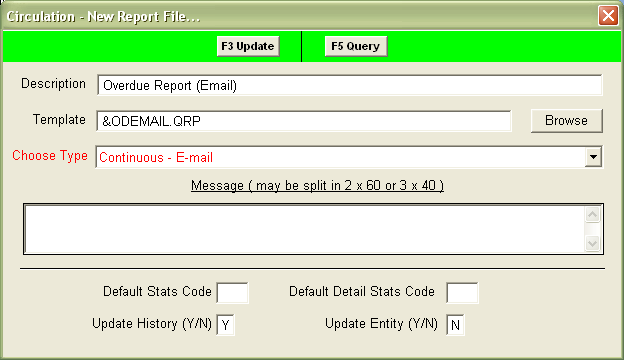
Set up the report: Overdue Email
Create report
- Go to Main > Reports > RepCirculation.
- Click the F1 New button.
- Highlight Overdue Notice (Email) (wording may differ – it will be using the &ODEMAIL.QRP print template) and click the Select button.
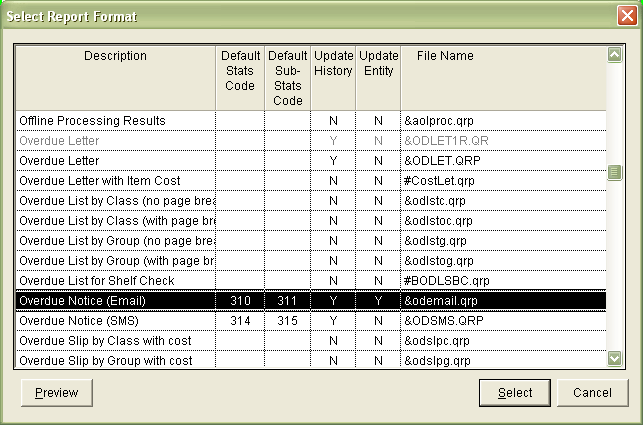
- Enter a Report Description – for example: Overdue Notices by Email.
- If you would like the borrower record to retain a record of any notice sent, then ensure that Create Hist (Y/N) = Y.
- If there are replacement costs involved, ensure that the Create Acct (Y/N) = Y.
- Click the F3 Save button.

Where statement
- Select the report from the list and click the F7 Where button. The Circulation Reports – Where screen will open
- The statement must include the following settings:
- Bor Email Address IS NOT NULL (Paste without placing a value in 3)
- Bor Use Email = Y
- Issue Date Back < Current Date (via Special button) – this can be altered to suit your particular needs.
- Click the F3 Save button.
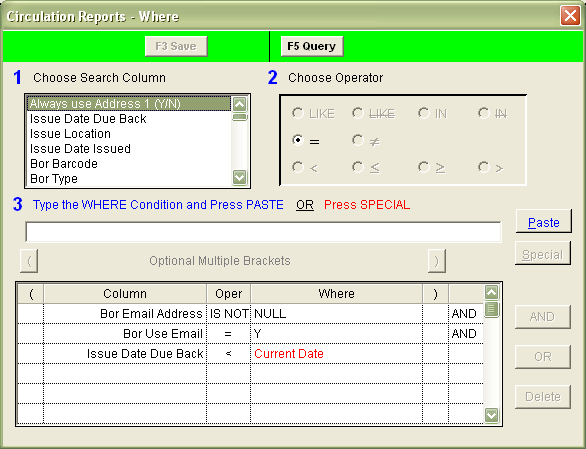
Order
- Select the report from the list and click on the F9 Order button. The Circulation Reports – Order By screen will open.
- Use the arrow keys to select fields to Order By – for example: Borrower Bar No.
- Click the F3 Save button.
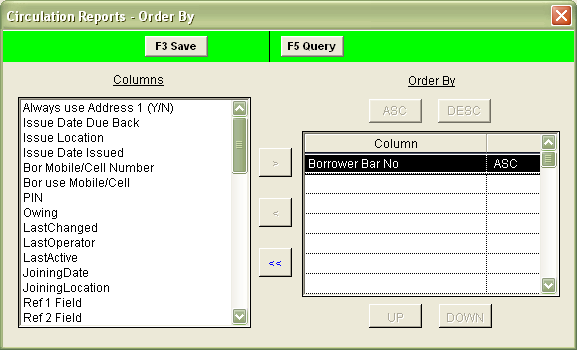
Set up the report: Reservation email
Create report
- Go to Main > Reports > RepReservation.
- Click the F1 New button.
- Highlight Email Reservation Notice (wording may differ – it will be using the &RESEML.QRP print template) and click Select.
- Enter a Report Description – for example: Reservation Notices by Email.
- If you would like the borrower record to retain a record of any notice sent, then ensure that Create Hist (Y/N) column = Y.
- Ensure Update Res Status column = Y (this will prevent notices from being printed twice).
- Click the F3 Save button.
Where statement
- Select the report from the list and click on the F7 Where button. The Reservation Reports – Where screen will open.
- The statement must include the following settings:
- Only Show First in Queue (Y/N) = Y (otherwise ALL reserves on an item will show).
- Res Item Status = RETURN – This status will change to PRINTED once this report is run, to prevent duplicate emails being sent.
- Bor Email Address IS NOT NULL (Paste without placing a value in 3).
- Bor Use Email (Y/N) = Y.
- (Optional) Res Collect Location = Temp Loc [select using the Special button] – This ensures that the item is at the collection location).
- (Optional) Res Collect Location = (enter your location code – for example: CHELSEA) – This will limit the notices sent to items for collection at the selected location.
- Click the F3 Save button.

Order
- Select the report from the list and click on the F9 Order button. The Reservation Reports – Order By screen will open.
- Use the arrow keys to select fields to Order By – for example: Borrower Bar No.
- Click the F3 Save button.
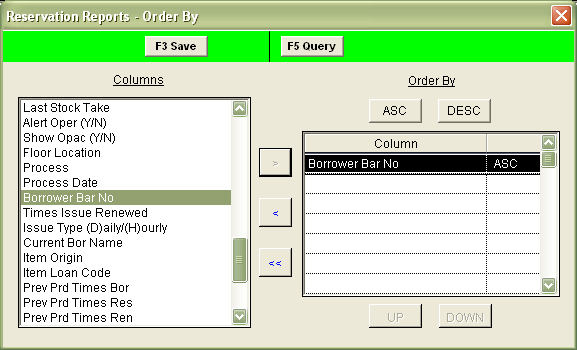
Print the emails
Using the Scheduler has two benefits over running reports via F8 View: It allows you to schedule regularly run reports so that staff do not have to do it manually each time, and it allows for further functions as part of the report such as updating Borrower/Stockitem history, creating financial accounts, changing records in the database and adding report information to your statistics. Email reports MUST be run via the Scheduler.
This section will take you through setting up a report to use RepStartSchedule.
Start the Scheduler
- From the Report screen (Main > Reports > RepCirculation or RepReservation), select Application > RepStartSchedule.
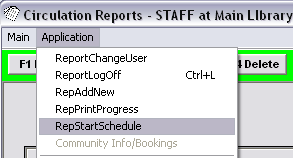
- The Report Scheduler screen will then open.
- Select your printing options: Ensure Email is ticked.
- Also decide If a report is scheduled by another user do you still want to print it? = Yes/No.
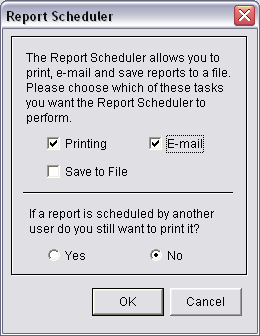
- Then select the OK button.
- After selecting “OK”, if you go back into the Application menu you will see that RepStartSchedule is now greyed out with a tick next to it – this indicates that the Scheduler is now running.

Note: If you need to restart the scheduler at any point, you will need to log out of all Report screens (Ctrl + L) and start at the beginning of these instructions.
Schedule the report
- With your report highlighted, select the F6 Print button
- A Print box will display where you can select from the following options:
- From:
- Database (to search the entire database)
- To:
- E-mail (to email it to patrons)
- Frequency:
- Once Only (if this is the only time you’re going to print this report)
- Daily (if you plan to send it every day)
- Weekly (if this is a once a week item)
- Monthly (if this is to be printed every calendar month)
- Every ___ days (if you want to set a specific schedule
- Schedule
- First Print Date (the day you want this report to begin its schedule)
- First Print Time (specifies the exact minutes the report will run)
- Selected Printer:
- You can specify any active printer on the network to print to – including virtual printer drivers such as a third party software that allows you to print to PDF (For example: CutePDF Writer)
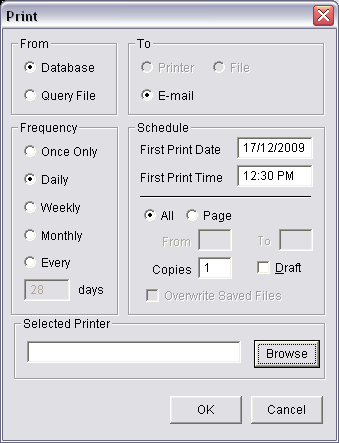
- You can specify any active printer on the network to print to – including virtual printer drivers such as a third party software that allows you to print to PDF (For example: CutePDF Writer)
- From:
- Once you have selected all of your settings, select the OK button.
Check print progress
- You can check the progress of your reports at any time by going into Main > Reports > RepPrintProgress.
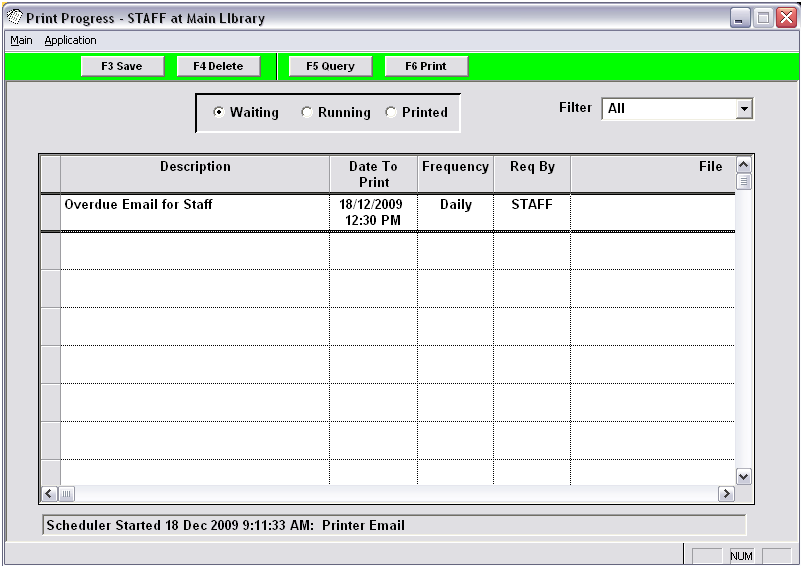
- If your library uses the scheduler for a lot of reports, you can select a frequency type from the Filter drop-down menu at the top.

- You can also click through the three tab options at the top to see the ones that are Waiting, Running, or have already been Printed.

- Your report will show up in “Printed” when it is complete.

Additional items
When scheduling reports, you must remember:
- The scheduler must be started prior to the time that reports are scheduled to run – you may have a procedure to start the scheduler first thing in the morning. Schedule your reports a bit later (e.g. if you start at 8:30am, then schedule the first report for 9:30am) so that if there are any unforeseen delays, the print schedule will still go as normal.
- Schedule reports with time to spare. Allow time for Amlib to be started and the scheduler to be started. Allow time between scheduled reports in case you need time to refill the printer, or something else happens.
- Check and stock the printer before the reports are due to run. Scheduling reports that print to file or send e-mails are somewhat easier to manage, so you may want to try the scheduling with these first. If you are scheduling printed reports, ensure that the printer is full of paper, not low on toner and if possible have someone near the printer when the reports are due to run, so they can fix any paper jams quickly.
- Check the ‘Waiting’ queue. Old reports that have not run can jam up the print queue and stop your scheduled reports from running. It is good practice when starting the scheduler for the day to check RepPrintProgress and delete out any old print jobs from the “Waiting” queue.
- Check and maintain your “Printed” queue. A large amount of print jobs in your printed queue can stop your reports from running. While there is ample space in this area to store information on past print jobs, the space in not unlimited. If the print jobs are not deleted on a regular basis (perhaps quarterly or every few months) this area will eventually become too full to allow the reports to run. It is fine to keep some print jobs in the “Printed” area of RepPrintProgress. Perhaps keep the last few days or few weeks and delete the rest. How many reports and how often you print will determine how far back you can keep this information.
- If scheduled reports do not run for some reason (there is a paper jam or the scheduler is not started, etc.) they will sit in the “Waiting” queue in RepPrintProgress and stop other reports from printing. If there is a delay, check the “Waiting” queue. If the reports due to run have a date/time next to them that has already passed, these will need to be deleted and then manually printed via the ‘print’ button.
- Check before your re-run reports. If there was a delay or paper jam and you have to run a report for a second time, check your settings before running it. If the report creates accounts for very overdue items, running it a second time will generate a second charge – it is best to run manually via F8 View and then print from the view screen. Do the same if you are adding history to records or recording statistics. Reservations will require a different procedure as they will already have their status changed to “Printed”.
Troubleshooting
Some users may experience some initial problems with SMTP emails not being sent. This can be the result of your anti-virus agent blocking programs that relay (mass) email or your mail server blocking relay (mass) emails.
There is now a complete Setting-Up Email and Troubleshooting Guide.
